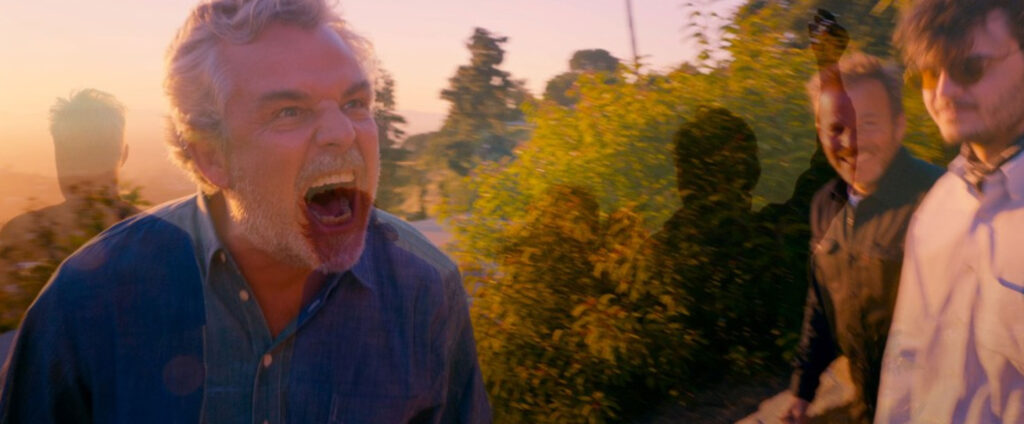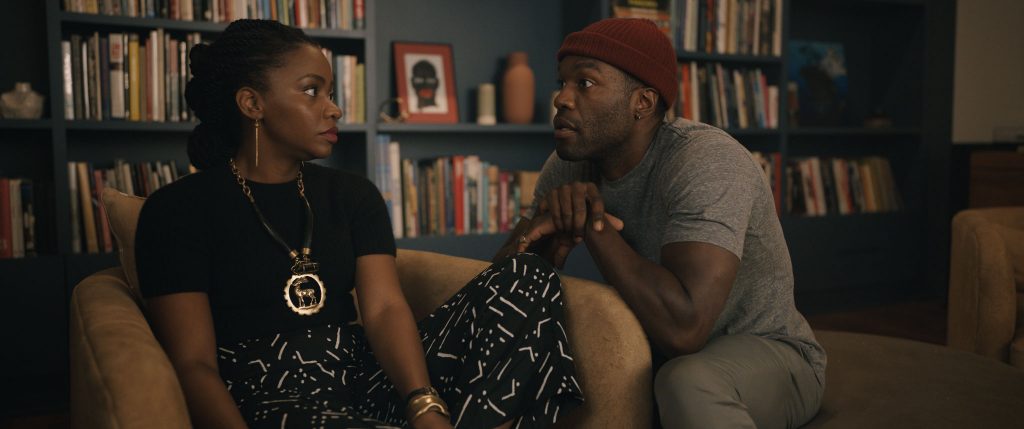August 30, 2022
by Carla Hay

Directed by Bernard Rose
Culture Representation: Taking place in Los Angeles on May 30 and May 31, 2020, the dramatic film “Traveling Light” features a predominantly white cast of characters (with a few African Americans and Asians) representing the working-class and middle-class.
Culture Clash: Various strangers, who end up crossing paths each other in some way or another, have different ways of coping with quarantine lockdowns and other restrictions caused by the COVID-19 pandemic.
Culture Audience: “Traveling Light” will appeal primarily to people who are fans of stars Danny Huston, Stephen Dorff and Tony Todd and any rambling and aimless movies that are a complete waste of time.

One of the many unfortunate effects of the COVID-19 pandemic on the entertainment industry is that it’s spawned a lot of awful movies with a COVID-19 theme. “Traveling Light” is one of these cinematic abominations. It’s utterly incoherent and pointless.
How bad is “Traveling Light”? When I saw the movie in a New York City movie theater, at a screening attended by members of the ticket-buying public, there were only three people in the room, including myself. By the end of the movie, the other two people—who clearly disliked the movie and couldn’t take watching it anymore—had walked out in disgust. One person left about halfway through the film, while the other person had enough of “Traveling Light’s” nonsense about three-quarters of the way through the movie.
Because I planned to review the film, I stayed until the bitter end. “Traveling Light” (written and directed by Bernard Rose) is so sloppily made, the end credits are very incomplete. The only end credits that showed up on screen were quick listings of the music composers and songwriters whose work could be heard in “Traveling Light.” There are student films and amateur YouTube videos that are more professionally made than “Traveling Light.”
“Traveling Light” writer/director Rose is best known for directing and co-writing the 1992 horror film “Candyman,” which spawned several inferior sequels and a 2021 reboot/sequel. “Candyman” and Rose’s 1994 drama “Immortal Beloved” (starring Gary Oldman) are probably Rose’s best-received movies by critics. All of Rose’s other movies have been considered middling or forgettable flops with critics and general audiences.
Rose’s connection to the original “Candyman” movie explains why original “Candyman” star Tony Todd is in “Traveling Light” in a completely underdeveloped and embarrassing role. Rose apparently also used his past working relationship with longtime British actor Danny Huston (who usually plays American characters in American-made movies) to lure Huston into the junkpile trap of making “Traveling Light.” Rose and Huston previously worked together on the the 2012 comedy/drama “2 Jacks” and a substandard 2015 remake of the horror classic “Frankenstein.”
“Traveling Light” takes place in Los Angeles during a 24-hour period from May 30 to May 31, 2020, during the pre-vaccine quarantined lockdown days of the COVID-19 pandemic. The movie is somewhat trying to be an experimental, avant-garde 2020 version of the 2005 Oscar-winning drama “Crash,” a movie showing various Los Angeles residents who are seemingly strangers to each other, but it’s eventually revealed how they cross paths and affect each other lives.
If “Crash” had any influence on “Traveling Light,” it’s not worth bragging about, since “Crash” is considered one of the worst Best Picture winners of all time at the Academy Awards. And “Traveling Light” is far from award-worthy. “Traveling Light” is such an obscure bomb, it’s not even notable enough to get on the radar of the Razzie Awards.
In “Traveling Light,” the movie goes back and forth between showing various neurotic characters who are mostly middle-aged. Harry (played by Huston) is a famous spiritual guru who has a cult-like following. He has gatherings in the homes of affluent people, under the guise that these gatherings are spiritual enlightenment seminars/retreats. “Traveling Light” shows one of these gatherings, which is really just a party where people take all sorts of drugs with Harry. Being a celebrity guru has taken an emotional toll on Harry’s marriage to his long-suffering wife Blue (Rosie Fellner), who is living in Harry’s shadow.
Todd (played by Stephen Dorff) is a semi-famous actor who is one of Harry’s devoted followers. Todd feels so restless and bored in his marriage to his loyal and responsible wife Mary (played by Olivia d’Abo), it’s not unusual for Todd to disappear for several days, so that he can avoid having to interact with Mary. After Todd does a virtual group meditation session with Harry, a star-struck Todd comments to Mary about Harry’s supposed genius skills: “I don’t think I can meditate that fast. He’s channeling something.”
Caddy (played by “Candyman” star Todd) is a brooding bachelor loner who has come out of retirement (his previous job is never mentioned) during the pandemic to become a rideshare driver because he doesn’t want to be cooped up in his house during a quarantine. Caddy is adamant that he and other people around him need to wear face masks during this pandemic. He is superstitious about getting infected with COVID-19, so he carries a bag of juju and a crucifix with him as good luck charms. Caddy is also dealing with the emotional pain of looking for his missing adult son Cecil, who is homeless and has mental health issues.
Arthur (played by Matthew Jacobs) is a British oddball with a fixation on trying to monitor people who are not wearing a mask and/or not social distancing. In one aggravatingly stupid sequence in the movie, Arthur uses his phone to video record a homeless couple named Anne (played by Jen Kuhn) and Blaster (played by Jeff Hilliard) because Anne and Blaster are not wearing masks and not social distancing while out on a public street. Anne and Blaster get annoyed when they see Arthur video recording them and tell him to stop. He refuses.
Arthur’s video recording is creepy but not illegal, as long as he doesn’t use the footage for any commercial purposes that would require signed release forms. For example, people on a public street can be recorded without their permission for security surveillance, for private (non-commercial use), or for news-gathering purposes. The problem is that Arthur refuses to tell Anne and Blaster where he’s going to put the video footage that he took of this homeless couple.
It leads to a confrontation where Anne and Blaster chase after Arthur on the street. They corner Arthur and get into a physical altercation with him, until Arthur agrees to delete the video footage. This sequence is neither amusing nor interesting. And it just makes Arthur look weird and petty, because homeless people have a lot bigger problems to worry about than a stranger trying to shame them for not social distancing on a street during this pandemic.
Arthur is acquainted with another eccentric who also has a very meddling and preachy attitude about whether or not people are wearing face masks in public. This busybody is named Gretchen (played by Vanessa Yuille), who has gone as far as making hand-held signs with slogans lecturing people to wear face masks. “Traveling Light” has some contrived and awkward-looking scenes where Arthur and Gretchen communicate by phone or meet each other in person to come up with schemes to catch people aren’t wearing face masks.
As far as Gretchen and Arthur are concerned, people who aren’t wearing face masks during the pandemic are health terrorists who are putting other people’s lives in danger. Gretchen proudly shows Arthur one of her hand-held signs, which says: “Don’t be a [dick], wear a mask!” Instead of the word “dick,” she put an illustration of a penis on the sign. Gretchen thinks the penis illustration is appropriate, while Arthur does not, and they debate about it. This is what’s supposed to pass as comedy in “Traveling Light.”
“Traveling Light” makes a very superficial attempt at having a social conscience, when the movie shows in its opening scene that Caddy (who is African American) is watching with despair some TV news about the civil rights protests following the death of George Floyd by police brutality. As most people know by now, Floyd was an unarmed, 46-year-old African American man who was murdered on a Minneapolis street by a white police officer who put his full body weight on Floyd’s neck, while three of the cop’s colleagues stood by and prevented bystanders from helping Floyd, who was begging for help. Floyd’s murder (which happened on May 25, 2020) was documented on video and led to worldwide protests over racist police brutality.
Unfortunately, “Traveling Light” does nothing substantial with the movie being set during the history-making anti-police-brutality protests in the days and weeks after Floyd’s murder. The movie could have explored the added anxiety that Caddy must have felt in knowing that his homeless son Cecil, a mentally ill African American man, is especially vulnerable to police brutality or unlawful arrests/detainments. Instead, these issues are tossed aside in “Traveling Light” like a discarded pandemic mask.
“Traveling Light” has tedious scenes showing the drug-induced ramblings of attendees at one of Harry’s retreats at a hillside mansion, where Harry hands out an unidentified liquid psychedelic drug that he calls an “elixir.” Harry repeats, “I ask for forgiveness, and I give forgiveness.” Todd is at one of these “retreats,” where various other drugs are consumed, including marijuana, cocaine, pills and alcohol. Expect to see some predictable druggie scenes that go nowhere and mean nothing.
Two people in their 20s named Clara (played by Lena Gora) and Sydney (played by Duke Nicholson) meet at this party and seem to have an attraction to each other. Too bad their drugged-out conversations are just the verbal equivalent of diarrhea. Sydney is so stoned, he can barely stand, let along comprehend what’s going on around him.
Clara then flirts with Todd when they end up alone together in a walk-in closet. Todd’s worried wife Mary suddenly shows up at the party and angrily demands to know what Clara is doing with recovering drug addict Todd, who is supposed to be clean and sober. Todd and Clara deny that anything sexual is going on between them. And then, Clara pretends that Sydney is her boyfriend. This part of the movie is like watching someone’s drugged-addled idea of a soap opera.
It should come as no surprise that some of these characters end up as passengers in Caddy’s car, as if he’s the only rideshare driver in Los Angeles. Caddy says at one point in the movie that he’s only been a rideshare driver for one day. The way that he berates some of his customers for not wearing masks, you get the feeling that he won’t last much longer as a rideshare driver because of all the bad reviews he’s going to get from customers. All of the cast members’ performances in “Traveling Light” range from lackluster to excruciatingly horrible.
At one point in this dreadful movie, Harry leads a group chant where he roars like an animal, because he’s so whacked out on drugs. His followers love it, because they think whatever comes out of Harry’s mouth is supposed to have some deeper meaning. “Traveling Light” is one of those pretentiously bad films that tries to make people think it has deeper meaning too, but it’s all just a sham that’s nothing but a load of rubbish and hot air.
Xenon Pictures released “Traveling Light” in select U.S. cinemas, beginning in Los Angeles on June 10, 2022, and in New York City and Seattle on August 19, 2022.


